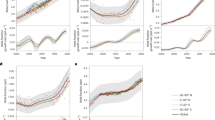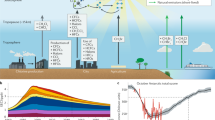Abstract
Chlorofluorocarbons (CFCs), along with bromine compounds, have been unequivocally identified as being responsible for most of the anthropogenic destruction of stratospheric ozone1. With curbs on emissions of these substances, the recovery of the ozone layer will depend on their removal from the atmosphere. As CFCs have no significant tropospheric removal process, but are rapidly photolysed above the lower stratosphere, the timescale for their removal is set mainly by the rate at which air is transported from the troposphere into the stratosphere2. Using a global climate model we predict that, in response to the projected changes in greenhouse-gas concentrations during the first half of the twenty-first century, this rate of mass exchange will increase by 3% per decade. This increase is due to more vigorous extra-tropical planetary waves emanating from the troposphere. We estimate that this increase in mass exchange will accelerate the removal of CFCs to an extent that recovery to levels currently predicted for 2050 and 2080 will occur 5 and 10 years earlier, respectively.
This is a preview of subscription content, access via your institution
Access options
Subscribe to this journal
Receive 51 print issues and online access
$199.00 per year
only $3.90 per issue
Buy this article
- Purchase on Springer Link
- Instant access to full article PDF
Prices may be subject to local taxes which are calculated during checkout



Similar content being viewed by others
References
Stratospheric Ozone 1999 (UK Stratospheric Ozone Review Group, Seventh report, HMSO, 1999).
Holton, J. R. et al. Stratosphere-troposphere exchange. Rev. Geophys. 33, 403–439 (1995).
Butchart, N., Austin, J., Knight, J. R., Scaife, A. A. & Gallani, M. L. The response of the stratospheric climate to projected changes in the concentrations of the well-mixed greenhouse gases from 1992–2051. J. Clim. 13, 2142–2159 (2000).
Butchart, N. & Austin, J. Middle atmosphere climatologies from the troposphere-stratosphere configuration of the UKMO's Unified Model. J. Atmos. Sci. 55, 2782–2809 (1998).
Cullen, M. J. P. The unified forecast/climate model. Meteorol. Mag. 122, 81–94 (1983).
Gregory, D., Shutts, G. J. & Mitchell, J. R. A new gravity-wave-drag scheme incorporating anisotropic orography and low-level wave breaking: Impact upon the climate of the UK Meteorological Office Unified Model. Q. J. R. Meteorol. Soc. 124, 463–493 (1998).
Mitchell, J. F. B., Johns, T. C., Gregory, J. M. & Tett, S. F. B. Climate response to increasing levels of greenhouse gases and sulphate aerosols. Nature 376, 501–504 (1995).
Houghton, J. T. et al. (eds) Climate Change 1995 Ch. 6 (Cambridge Univ. Press, Cambridge, 1996).
Rosenlof, K. H. Seasonal cycle of the residual mean meridional circulation in the stratosphere. J. Geophys. Res. 100, 5173–5191 (1995).
Mote, P. W. et al. An atmospheric tape recorder: The imprint of tropical tropopause temperatures on stratospheric water vapor. J. Geophys. Res. 101, 3989–4006 (1996).
Mote, P. W. et al. Vertical velocity, vertical diffusion, and dilution by midlatitude air in the tropical lower stratosphere. J. Geophys. Res. 103, 8561–8666 (1998).
Yulaeva, E., Holton, J. R. & Wallace, J. M. On the cause of the annual cycle in tropical lower-stratospheric temperatures. J. Atmos. Sci. 51, 169–174 (1994).
Andrews, D. G. & McIntrye, M. E. Planetary waves in horizontal and vertical shear: The generalized Eliassen-Palm relation and the mean zonal acceleration. J. Atmos. Sci. 33, 2031–2048 (1976).
Andrews, D. G. & McIntrye, M. E. Generalized Eliassen-Palm and Charney-Drazin theorems for waves on axisymmetric mean flows in compressible atmospheres. J. Atmos. Sci. 35, 175–185 (1978).
Mahfouf, J. F., Cariolle, D., Royer, J.-F., Gelyn, J.-F. & Timbal, B. Response of the Météo-France climate model to changes in CO2 and sea surface temperature. Clim. Dyn. 9, 345–362 (1994).
Rind, D., Shindell, D., Lonergan, P. & Balachandran, N. K. Climate change in the middle atmosphere. Part III: the doubled CO2 climate revisited. J. Clim. 11, 876–894 (1998).
Haynes, P. H., Marks, C. J., McIntyre, M. E., Shepherd, T. G. & Shine, K. P. On the “downward control” of the extratropical diabatic circulations by eddy-induced mean zonal forces. J. Atmos. Sci. 48, 651–678 (1991).
Rosenlof, K. H. & Holton, J. R. Estimates of the stratospheric residual circulation using the downward control principle. J. Geophys. Res. 98, 10465–10479 (1993).
Madronich, S. et al. in Scientific Assessment of Ozone Depletion: 1998 Ch. 11 (World Meteorological Organization, Geneva, 1999).
Brasseur, G. & Solomon, S. Aeronomy of the Middle Atmosphere (Reidel, Dordrecht, 1984).
Ko, M. K. W. et al. in Report on the Concentrations, Lifetimes, and Trends of CFCs, Halons, and Related Species (eds Kaye, J. A., Penkett, S. A. & Ormond, F. M.) Ch. 5 (Reference publication 1339, NASA, Washington DC, 1994).
Shindel, D. T., Rind, D. & Lonergan, P. Increased polar stratospheric ozone losses and delayed eventual recovery owing to increasing greenhouse-gas concentrations. Nature 392, 589–592 (1998).
Waibel, A. E. et al. Arctic ozone loss due to denitrification. Science 283, 2064–2068 (1999).
Austin, J., Knight, J. & Butchart, N. Three-dimensional chemical model simulations of the ozone layer: 1979–2015. Q. J. R. Meteorol. Soc. 126, 1533–1556 (2000).
Austin, J., Butchart, N. & Knight, J. Three-dimensional chemical model simulations of the ozone layer: 2015–2055. Q. J. R. Meteorol. Soc. (in the press).
Pawson, S. et al. The GCM-Reality Intercomparison Project for SPARC (GRIPS): Scientific issues and initial results. Bull Am. Meteorol. Soc. 81, 781–795 (2000).
Hofmann, D. J. et al. in Scientific Assessment of Ozone Depletion: 1998 Ch. 12 (World Meteorological Organization, Geneva, 1999).
Andrews, D. G., Holton, J. R. & Leovy, C. B. Middle Atmosphere Dynamics Ch. 3 (Academic, London, 1987).
Dunkerton, T., Hsu, C.-P. F. & McIntyre, M. E. Some Eulerian and Lagrangian diagnostics for a model stratospheric warming. J. Atmos. Sci. 38, 819–843 (1981).
Prinn, R. G. et al. in Scientific Assessment of Ozone Depletion: 1998 Ch. 1 (World Meteorological Organization, Geneva, 1999).
Acknowledgements
We thank J. Austin, B. Callander, R. Derwent, J. Knight and R. Swinbank for comments. This work was supported by the Public Meteorological Services Research Programme of The Met Office, and the UK Department of the Environment, Transport and the Regions.
Author information
Authors and Affiliations
Corresponding author
Rights and permissions
About this article
Cite this article
Butchart, N., Scaife, A. Removal of chlorofluorocarbons by increased mass exchange between the stratosphere and troposphere in a changing climate. Nature 410, 799–802 (2001). https://doi.org/10.1038/35071047
Received:
Accepted:
Issue Date:
DOI: https://doi.org/10.1038/35071047
This article is cited by
-
Dependence of column ozone on future ODSs and GHGs in the variability of 500-ensemble members
Scientific Reports (2023)
-
The Role of Ozone Depletion in the Lack of Cooling in the Antarctic Upper Stratosphere during Austral Winter
Advances in Atmospheric Sciences (2023)
-
Role of Stratospheric Processes in Climate Change: Advances and Challenges
Advances in Atmospheric Sciences (2023)
-
Evaluating the Ozone Valley over the Tibetan Plateau in CMIP6 Models
Advances in Atmospheric Sciences (2022)
-
Challenges for the recovery of the ozone layer
Nature Geoscience (2019)
Comments
By submitting a comment you agree to abide by our Terms and Community Guidelines. If you find something abusive or that does not comply with our terms or guidelines please flag it as inappropriate.



